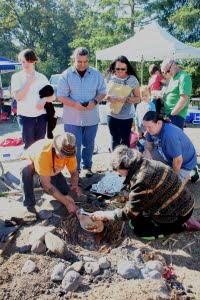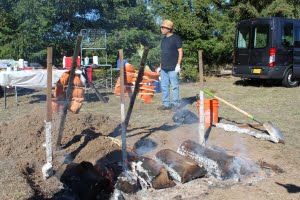
First Foods Celebration at Champoeg State Park
By Andy Neill
October 2018
On Saturday October 13th, IAE staff took part in a cultural event at Champoeg State Heritage Area and State Park near Wilsonville, Oregon, that was the culmination of the efforts with our partners at Confederated Tribes of the Grand Ronde (CTGR) and Oregon Parks and Recreation Department (OPRD). The event was part of the Plants for People Project, funded by the Oregon Watershed Enhancement Board (OWEB), celebrating the establishment of a harvesting area at Champoeg State Park. Volunteers, tribal members, and staff from IAE, OPRD, and CTGR planted 1,500 tall camas (Camassia leichtlinii) bulbs and yampa (Perideridia gairdneri) roots in a location where local tribes will eventually be able to come together annually to collect first foods and share their traditions.
This planting area is part of a 45-acre prairie restoration project IAE has conducted at the State Park near the Willamette River. This restoration project is funded by OPRD, OWEB and other grants with the goal of improving plant diversity at the site. Champoeg, a Kalapuyan word that refers to yampa, was an important gathering area to harvest first foods and trade goods with other local tribes. The site eventually became the town site for Champoeg, an important American historical site in which a provisional Oregon state government was approved by early settlers, becoming the first site of organized American government in the Pacific Coast region. Champoeg eventually lost to Salem as the state capital, however, and in 1861 the Willamette River flooded and destroyed the town which was never rebuilt. The field was farmed until this restoration project began in 2013.


In addition to planting, attendees from CTGR and passersby enjoyed cultural demonstrations that included a camas oven, basketry, handmade tools and prairie ecology. The oven would have been used to cook camas over the course of two days, but instead it cooked carrots and potatoes for this event. The hole for the oven was dug the night before and lined with carefully selected rocks. On the morning of the event, a fire was started in the oven and kept burning until the rocks were red hot. The remaining wood and ashes were removed, and cattails doused with water lined the oven. Instead of camas, carrots and potatoes were placed in the bed of wet cattails and covered with more cattails, handkerchiefs, soil and four capstones that had been heated by the fire. The purpose of the handkerchiefs was to keep dirt and ash from falling onto the food being cooked in the oven when they were covered by soil and hot rocks to cook. The vegetables cooked for a few hours then dug up and revealed to curious onlookers. The potatoes and carrots were served for lunch with salmon that was cooked using traditional methods over an open fire.
Our goal with this celebration is to continue the tradition of gathering food from the Champoeg, cooking and feeding it to people to honor the historical culture of the site so future generations can understand how tribes of the area used the native plants. We hope this can become an annual event celebrating the foods, location, and people of the Kalapuya.


Restoration
Research
Education
Contact
Main Office:
4950 SW Hout Street
Corvallis, OR 97333-9598
541-753-3099
info@appliedeco.org
Southwest Office:
1202 Parkway Dr. Suite B
Santa Fe, NM 87507
(505) 490-4910
swprogram@appliedeco.org
© 2025 Institute for Applied Ecology | Privacy Policy
